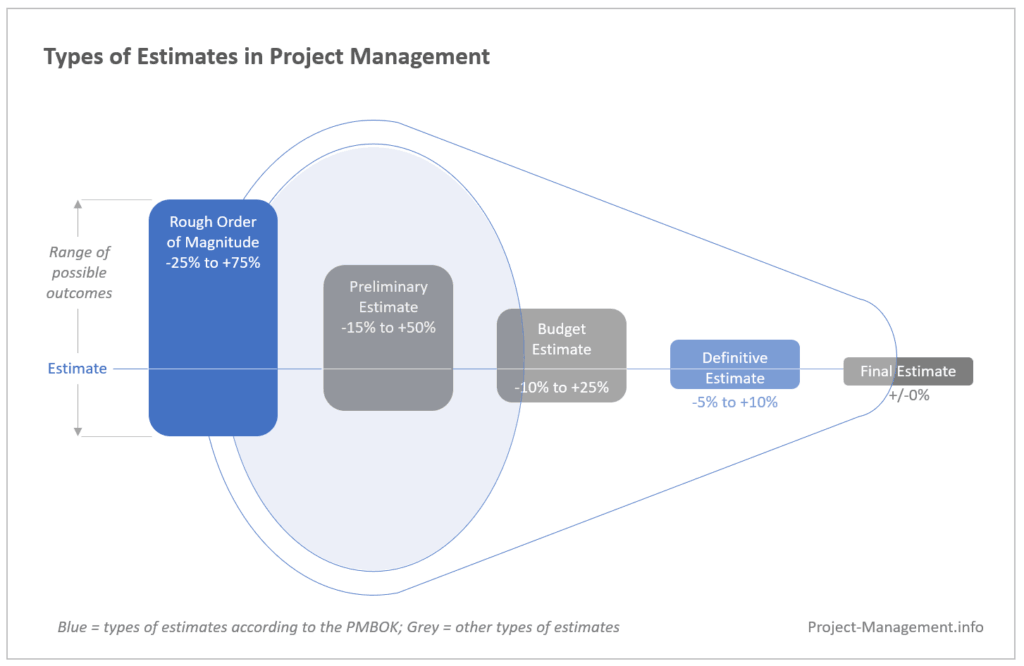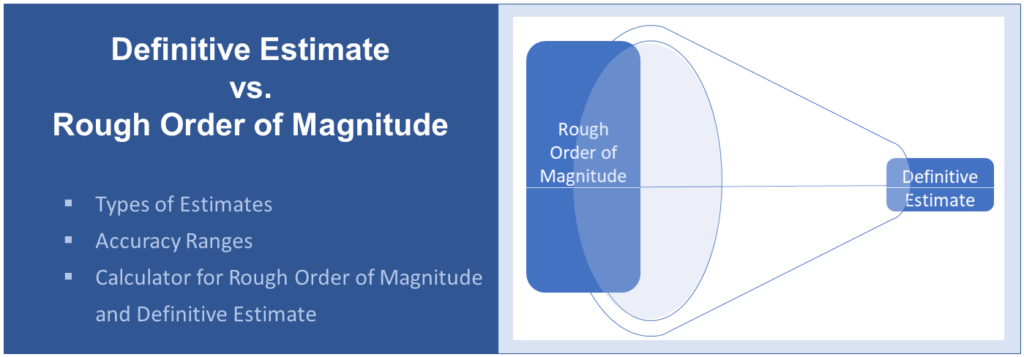When the cost of projects (or parts of a project) is estimated, the accuracy of these estimates depends on various factors. These include but are not limited to the availability and quality of information and the estimation technique used. The available options and data to estimate costs typically vary among the phases of a project.
Definitive estimate and rough order of magnitude (ROM) are two classes of estimates that are defined in PMI’s Project Management Body of Knowledge. They differ in their levels of accuracy. ROM normally has an accuracy range between -25% and +75%. For definitive estimates, it ranges from -5% to +10% (PMBOK®, 6th ed., ch. 7.2).
Read on to learn more about the types of estimates and use the calculator embedded in this article to quantify the ranges of your project.
Types and Accuracy Classes of Estimates
In project management, there is a terminology for the classification of cost estimates by their accuracy. When communicating estimated costs (or durations), indicating the type of estimates provides important background on the accuracy of the estimates.
Common terms include:
- Rough order of magnitude (ROM)*,
- Budget estimate,
- Definitive estimate*, and
- other terms, such as preliminary estimates, control estimate, bid estimate, final estimate, etc.
The types marked with an asterisk (*) are in accordance with the current PMI framework. Unfortunately, the use of these terms and the underlying ranges vary significantly across industries and organizations. Some organizations use their own frameworks with internally predefined ranges of such accuracy classifications. Read on for some examples of such types and accuracy ranges.

Types of Estimates Mentioned in the PMBOK®
In this section, we focus on the terms and definitions set out in the Project Management Institute’s framework which are also relevant for the PMP exam.
Rough Order of Magnitude
The rough offer of magnitude is a ballpark figure that is usually created in very early phases of a project, e.g. during its initiation or even earlier – in the cost-benefit analysis during the project selection process, for instance.
Its accuracy range is -25% to +75% according to the current PMBOK (ch. 7.2). In earlier editions of the PMBOK®, such as its 4th edition, the range had been defined as +/-50%. However, if you are preparing for a PMP exam right now, you should memorize -25% and +75%.
This means that the cost that has been incurred by a project typically falls within that range of the initial ROM estimate.
With its broad range of possible outcomes, ROM estimates are rather imprecise. Therefore, they are normally replaced with more accurate estimates, such as the definitive estimate, during the project.
Definitive Estimate
The definitive estimate is the most exact type of estimate defined in the PMBOK. Its accuracy ranges from -5% to +10% (ch. 7.2).
This high level of accuracy can normally only be achieved when the project has been planned in detail and the information relevant for a reliable estimation of the work is available.
Thus, definitive estimates are usually developed later in a project while a rough order of magnitude is more common in very early stages of a project.
The refinement of rough estimates during the course of the project is sometimes referred to as progressive elaboration. Once a definitive estimate can be developed, it usually replaces the precious, less precise estimate.
Other Types of Estimates
The following estimate types are not listed in the latest edition of PMI’s PMBOK. However, they can be relevant in practice to bridge the large gap between the accuracy ranges of the rough order of magnitude and the definitive estimate.
Preliminary Estimates
Preliminary estimates come with a range of -15% to +50% (source). While this is still not very precise, it is a significant enhancement compared with the range of the rough order of magnitude.
Budget Estimate
Budget estimates are way more exact than order of magnitude estimates. They come with an accuracy range of -10% to +25% (source) or -15% to +30% (Source: Homer, J.L.: Successful outcome forecasting for projects, 2007, available in the PMI Learning Library).
This type of estimate is useful when a project proceeds in its planning or when budgets need to be allocated across the work breakdown structure. A ROM could be too rough to allow for a proper breakdown and allocation of a budget.
Final Estimate
The Final estimate is deemed not to have any deviation from the actual cost at completion, hence the accuracy range is 0% (source).
In the early phases of a project, it may not be feasible to achieve this level of accuracy. However, it could be achievable in some cases when the planning and work breakdown structure has been developed, all required information is available and one of the more accurate estimation techniques is used.
An example of the development of a final estimate is the re-estimation during a project. In such cases, an Estimate at Completion (EAC) is developed that might come with a 0% deviation if techniques with a high level of accuracy (such as bottom-up estimating) are used.
How Are These Estimates Developed?
Among the most common estimation techniques are:
- Expert Judgement
- Analogous Estimating
- Parametric Estimating
- Bottom-up Estimating
- Three-Point Estimating
Read this article for a comprehensive introduction and comparison of estimation techniques.
Of these techniques, parametric and bottom-up estimating are normally the most accurate ones (yet time-consuming and resource-intense). Thus, they are commonly used for definitive estimates and other relatively accurate types of estimates.
Analogous estimation and expert judgment are often deemed to produce rather rough estimates. yet, this is not necessarily always the case. However, these techniques can be used for ROM or preliminary estimates.
Three-point estimating as well as tri-angular and Pert distributions can be used to enhance the accuracy of any of these estimation techniques. You will learn more about it in this article that also includes an illustrative example of their uses.
Another technique relevant to cost estimating is progressive elaboration. This involves updating initial rough estimates with more accurate numbers as more and more information becomes available throughout a project.
Calculator: Definitive Estimate vs. Rough Order of Magnitude (ROM)
Use this calculator to get a quantification of the differences between the types of cost estimates. Just enter the cost estimate and select the type of estimate to calculate the range of possible outcomes.
Conclusion
Using common terminology for the accuracy of estimates helps project managers and stakeholders understand the quality and reliability of cost estimates. However, different organizations and frameworks use different terms and ranges. When working on cost estimates in a project, it is important that you adhere to the definitions established in your organization.
If you are working on a PMI-style project or preparing for the PMP exam, you will need to know 2 types of cost estimates: the rough order of magnitude (ROM) with an accuracy between -25% and +75% (read more in this article) and the definitive estimate with an accuracy of -5% to +10%.
Budget and preliminary estimates are not explicitly mentioned in the PMBOK. However, they can be useful in practice if the accuracy of an estimate is somewhere between ROM and definitive estimate.
The accuracy of an estimate depends on the quality and availability of information and the estimation technique that is used. For further background, read this article about the different estimation techniques where we have also addressed the data needs and pros and cons of each technique.


Comments are closed.